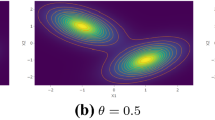Abstract
Analysis of empirical data considered to be mixtures of a finite number of end members has been a topic of increasing interest recently. The algorithms EXTENDED CABFAC and QMODEL by Klovan and Miesch (1976) represent a satisfactory solution to this problem if pure end members are captured within the data set or if the composition of “true” end members are known a priori. Where neither condition is satisfied, the composition of “external” end members can, under certain conditions, be deduced from the structure of the data. Described herein is an algorithm termed EXTENDED QMODEL which defines feasible end members which are “closest” to the data envelope.
Similar content being viewed by others
References
Bezdek, J. C., 1974, Numerical Taxonomy with fuzz sets: J. Math. Biol., v. 1, n. 1, p. 57–71.
Bezdek, J. C., 1980, Pattern recognition with fuzzy objective function algorithms: Plenum, New York.
Brown, P. Jeffrey, Ehrlich, R., and Colquhoun, D., 1980, Origin of patterns of quartz sand types on the southeastern United States continental shelf and its implication on contemporary shelf sedimentation—Fourier grain shape analysis: Jour. Sed. Pet., v. 50, no. 2, p. 1095–1110.
Clarke, Thomas L., 1978, An oblique factor analysis solution for the analysis of mixture: Jour. Math. Geol., v. 10, no. 2, p. 225–241.
Full, W. E., Ehrlich, R., Bezdek, J. C., FUZZY QMODEL: a new approach for linear unmixing: Jour. Math. Geol., to appear.
Harman, H. H., 1967, Modern factor analysis (2nd ed.): Univ. Chicago Press, Chicago, 474 p.
Hudson, C. B. and Ehrlich, R., 1980, Determination of relative provenance contributions in samples of quartz sand usingQ-mode factor analysis of Fourier grain shape data: Jour. Sed. Pet., v. no. 4, p. 1101–1110.
Imbrie, J. and Van Andel, T. H., 1964, Vector analysis of heavy mineral data: Bull. Geol. Soc. Amer., v. 75, p. 1131–1156.
Klovan, J. E. and Miesch, A. T., 1976, EXTENDED CABFAC and QMODEL computer profrom grain-size distributions: Jour. Sed. Pet., v. 36, no. 1, p. 115–125.
Klovan, J. E. and Imbrie, J., 1971, An algorithm and FORTRAN-IV program for large scaleQ-mode factor analysis and calculation of factor scores: Jour. Math. Geol., v. 3, no. 1, p. 61–76.
Klovan, J. E. and Miesch, A. T., 1976, EXTENDED CABFAC and QMODEL computer programs forQ-mode factor analysis of compositional data: Comput. Geosci., v. L, no. 3, p. 161–178.
Mazzullo, J. and Ehrlich R., 1980, A vertical pattern of variation in the St. Peter Sandstone-Fourier grain shape analysis: Jour. Sed. Pet., v. 50, no. 1, p. 63–70.
Miesch, 1976a,Q-mode factor analysis of geochemical and petrologic data matrices with constant row sums: U.S.G.S. Prof. Paper 574G.
Miesch, 1976b,Q-mode factor analysis of compositional data: Comput. Geosci., v. 1, no. 3, p. 147–159.
Spencer, D. W., 1967, Factor analysis II: a description of the application of oblique solutions: Woods Hole Oceanographic Inst., ref. no. 67-59, p. 37
Author information
Authors and Affiliations
Additional information
This research was supported in part by a grant from the Office of Naval Research (N00014-78C-0698 Code 483).
Rights and permissions
About this article
Cite this article
Full, W.E., Ehrlich, R. & Klovan, J.E. EXTENDED QMODEL—objective definition of external end members in the analysis of mixtures. Mathematical Geology 13, 331–344 (1981). https://doi.org/10.1007/BF01031518
Received:
Issue Date:
DOI: https://doi.org/10.1007/BF01031518




